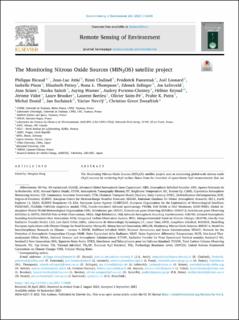| dc.contributor.author | Ricaud, Philippe | |
| dc.contributor.author | Attié, Jean-Luc | |
| dc.contributor.author | Chalinel, Rémi | |
| dc.contributor.author | Pasternak, Frédérick | |
| dc.contributor.author | Léonard, Joël | |
| dc.contributor.author | Pison, Isabelle | |
| dc.contributor.author | Pattey, Elizabeth | |
| dc.contributor.author | Thompson, Rona Louise | |
| dc.contributor.author | Zelinger, Zdenek | |
| dc.contributor.author | Lelieveld, Jos | |
| dc.contributor.author | Sciare, Jean | |
| dc.contributor.author | Saitoh, Naoko | |
| dc.contributor.author | Warner, Juying | |
| dc.contributor.author | Fortems-Cheiney, Audrey | |
| dc.contributor.author | Reynal, Hélène | |
| dc.contributor.author | Vidot, Jérôme | |
| dc.contributor.author | Brooker, Laure | |
| dc.contributor.author | Berdeu, Laurent | |
| dc.contributor.author | Saint-Pé, Olivier | |
| dc.contributor.author | Patra, Prabir K. | |
| dc.contributor.author | Dostál, Michal | |
| dc.contributor.author | Suchánek, Jan | |
| dc.contributor.author | Nevrlý, Václav | |
| dc.contributor.author | Zwaaftink, Christine Groot | |
| dc.date.accessioned | 2021-10-07T11:24:40Z | |
| dc.date.available | 2021-10-07T11:24:40Z | |
| dc.date.created | 2021-09-29T16:03:25Z | |
| dc.date.issued | 2021 | |
| dc.identifier.citation | Remote Sensing of Environment. 2021, 266, 112688. | en_US |
| dc.identifier.issn | 0034-4257 | |
| dc.identifier.uri | https://hdl.handle.net/11250/2788385 | |
| dc.description.abstract | The Monitoring Nitrous Oxide Sources (MIN2OS) satellite project aims at monitoring global-scale nitrous oxide (N2O) sources by retrieving N2O surface fluxes from the inversion of space-borne N2O measurements that are sensitive to the lowermost atmospheric layers under favorable conditions. MIN2OS will provide emission estimates of N2O at a horizontal resolution of 1° × 1° on the global scale and 10 × 10 km2 on the regional scale on a weekly to monthly basis depending on the application (e.g., agriculture, national inventories, policy, scientific research). Our novel approach is based on the development of: 1) a space-borne instrument operating in the Thermal InfraRed domain providing, in clear sky conditions, N2O mixing ratio in the lowermost atmosphere (900 hPa) under favorable conditions (summer daytime) over land and under favorable and unfavorable (winter nighttime) conditions over the ocean and 2) an atmospheric inversion framework to estimate N2O surface fluxes from the atmospheric satellite observations. After studying three N2O spectral bands (B1 at 1240–1350 cm−1, B2 at 2150–2260 cm−1 and B3 at 2400–2600 cm−1), a new TIR instrument will be developed, centered at 1250–1330 cm−1, with a resolution of 0.125 cm−1, a Full Width at Half Maximum of 0.25 cm−1 and a swath of 300 km. To optimally constrain the retrieval of N2O vertical profiles, the instrument will be on-board a platform at ~830 km altitude in a sun-synchronous orbit crossing the Equator in descending node at 09:30 local time in synergy with two other platforms (Metop-SG and Sentinel-2 NG) expected to fly in 2031–32 aiming at detecting surface properties, agricultural information on the field scale and vertical profiles of atmospheric constituents and temperature. The lifetime of the MIN2OS project would be 4–5 years to study the interannual variability of N2O surface fluxes. The spectral noise can be decreased by at least a factor of 5 compared to the lowest noise accessible to date with the Infrared Atmospheric Sounding Interferometer-New Generation (IASI-NG) mission. The N2O total error is expected to be less than ~1% (~3 ppbv) along the vertical. The preliminary design of the MIN2OS project results in a small instrument (payload of 90 kg, volume of 1200 × 600 × 300 mm3) with, in addition to the spectrometer, a wide field and 1-km resolution imager for cloud detection. The instruments could be hosted on a small platform, the whole satellite being largely compatible with a dual launch on VEGA-C. The MIN2OS project has been submitted to the European Space Agency Earth Explorer 11 mission ideas. | en_US |
| dc.language.iso | eng | en_US |
| dc.rights | Navngivelse 4.0 Internasjonal | * |
| dc.rights.uri | http://creativecommons.org/licenses/by/4.0/deed.no | * |
| dc.title | The Monitoring Nitrous Oxide Sources (MIN2OS) satellite project | en_US |
| dc.type | Peer reviewed | en_US |
| dc.type | Journal article | en_US |
| dc.description.version | publishedVersion | en_US |
| dc.rights.holder | © 2021 The Authors. Published by Elsevier Inc. | en_US |
| dc.source.volume | 266 | en_US |
| dc.source.journal | Remote Sensing of Environment | en_US |
| dc.identifier.doi | 10.1016/j.rse.2021.112688 | |
| dc.identifier.cristin | 1940766 | |
| dc.relation.project | NILU: 119073 | en_US |
| dc.source.articlenumber | 112688 | en_US |
| cristin.ispublished | true | |
| cristin.fulltext | original | |
| cristin.qualitycode | 2 | |

